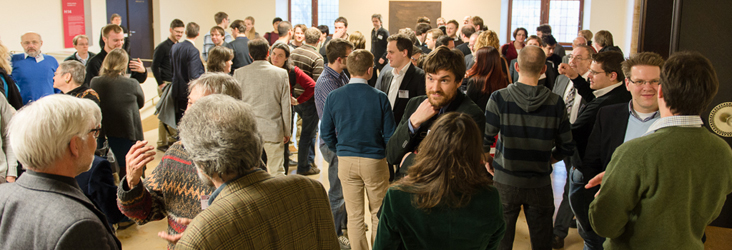
Events 2016
The Interdisciplinary Center for Scientific Computing (IWR) and its affiliated institutions organize a large number of events for discussing latest scientific results as well as identifing upcoming challenges in the field of Scientific Computing. In addition the IWR regularly hosts events which emphasis on broadening and improving the interdisciplinary dialogue.
Talk
"Coupling fluid-structure interaction with phase-field fracture"
Dr. Thomas Wick • Ecole Polytechnique Paris-Palaiseau, France
December 21, 2016 • 14:15
In this presentation, a concept for coupling fluid-structure interaction with brittle fracture in elasticity is proposed. The fluid-structure interaction problem is modeled in terms of the arbitrary Lagrangian-Eulerian technique and couples the isothermal, incompressible Navier-Stokes equations with nonlinear elastodynamics using the Saint-Venant Kirchhoff solid model. The brittle fracture model is based on a phase-field approach for cracks in elasticity and pressurized elastic solids. In order to derive a common framework, the phase-field approach is re-formulated in Lagrangian coordinates to combine it with fluid-structure interaction. A crack irreversibility condition, that is mathematically characterized asan inequality constraint in time, is enforced with the help of an augmented Lagrangian iteration. The resulting problem is highly nonlinear and solved with a modified Newton method (e.g., error-oriented) that specifically allows for a temporary increase of the residuals. The proposed framework is substantiated with several numerical tests. In these examples, computational stability in space and time is shown for several goal functionals, which demonstrates reliability of numerical modeling and algorithmic techniques. But also current limitations such as the necessity of using solid damping are addressed.
Location: Mathematikon • Conference Room / 5th Floor • Im Neuenheimer Feld 205 • 69120 Heidelberg
Talk
"Matrix-free block-smoothers for higher-order DG methods"
Dr. Eike Müller • University of Bath, UK
December 15, 2016 • 16:15
To fully utilise computational resources for applications based on Discontinuous Galerkin discretisations, efficient and algorithmically optimal implementations are necessary. Traditionally a given PDE is solved by assembling a system of sparse equations and inverting the resulting matrix equation algebraically, for example with an AMG method. However, on modern multicore chip architectures with a poor FLOP-to-bandwidth ratio this approach becomes very expensive. Let N denote the number of unknowns per element. To apply the operator, in each grid cell a matrix of size N x N has to be loaded from memory and a dense matrix-vector multiplication with low arithmetic intensity is carried out; the overall cost of the method is O(N^2). This cost is reduced by matrix-free implementations where the matrix is re-calculated on-the fly. For tensor-product elements in d dimensions sum factorisation techniques reduce the computational complexity from O(N^2)=O(n^{2d}) to O(d*n^{d+1}), where n is the number of unknowns in one direction.
In preconditioned Krylov-subspace solvers and multigrid smoothers it is often necessary to invert block-diagonal matrices. Even though the action of A is implemented in a matrix-free way, local block-matrices D_e of size n^d x n^d are assembled in each cell and then inverted with an exact LU- or Cholesky-factorisation. Overall this requires O(n^{2d}) bandwidth-bound operations and quickly becomes the bottleneck of the solver as the order n increases. To circumvent this problem, we solve the system D_e.x=y approximately with an iterative method. Since the application of D_e can be implemented in a matrix-free way, the action of D_e^{-1} becomes FLOP bound and the cost decreases from O(n^{2d}) to O(n_{iter} * d * n^{d+1}) where n_{iter} is the number of iterations required to solve the system in each cell.
We study the efficiency of this approach for the solution of linear convection-diffusion systems; problems of this type arise, for example, in operator splitting approaches for unstable porous media flow. We demonstrate the algorithmic and computational efficiency of the method for a hybrid multigrid algorithm with hp-coarsening, similar to [Bastian et al. (2012), Num. Lin. Alg. with Appl. 19 (2), pp. 367-388]: on the finest level a matrix-free block-Jacobi or block-SSOR smoother is applied to the high-order system, and the low-order system on the coarser levels is solved with AMG.
All code is implemented in the EXADUNE code base and we demonstrate the efficiency of our approach for a range of elliptic PDEs, including a convection-dominated problem and the stationary SPE10 benchmark.
Authors: Eike Müller (University of Bath), Peter Bastian, Steffen Müthing, Marian Piatkowski (Heidelberg University)
Location: Mathematikon • Seminar Room 11 • Im Neuenheimer Feld 205 • 69120 Heidelberg

12. Modellierungstag Rhein-Neckar
"Datenvisualisierung: Wie aus reinen Daten ein verständliches Bild entsteht"
8. Dezember 2016 • 14:00 Uhr
Die Bedeutung von Information als Rohstoff und Ware steigt stetig – und prägt weite Bereiche unseres sozialen und ökonomischen Lebens. Die daraus resultierende Informationsexplosion stellt uns vor vielfältige Probleme. Die Erhebung, die Speicherung und der Austausch dieser Daten können vergleichsweise einfach bewerkstelligt werden. Das weitaus schwierigere mittel- und langfristige Ziel dieses Prozesses muss in der Nutzbarmachung dieser Daten liegen, das heißt in der analytischen Interpretation und Wissensbildung.
Das menschliche visuelle System ist der Datenkanal mit der größten Bandbreite in unser Gehirn und bietet dabei eine Vielzahl von Reduktions- und Abstraktionsmechanismen. Die Isolierung von wichtigen Details in einer Flut von Informationen gehört zu seinen wichtigsten Aufgaben. Die computergestützte Visualisierung macht sich diesen massiv parallelen Datenkanal zu Nutze, indem sie graphikorientierte Techniken entwickelt, die eine effektive Analyse großer Datenmengen erlauben. So kann sie helfen, die Spreu vom Weizen zu trennen, indem sie gesuchte Strukturen und Mechanismen definiert, extrahiert und im wissensbildenden Prozess präsentiert.
Der Modellierungstag will den Gedankenaustausch zwischen Forschern, Entwicklern, Theoretikern und Anwendern der mathematischen Optimierung in der Industrie fördern. Als Diskussionsgrundlage dienen dabei u.a.:
- Praktische Fragestellungen aus der Industrie
- Erfahrungsberichte über Anwendungen mit Software und Algorithmen aus dem Gebiet mathematische Optimierung
- Vorstellung von Softwarewerkzeugen, die den Einsatz mathematischer Programmierung in der Praxis effektiver gestalten
Die Veranstaltung ist öffentlich. Die Teilnahme ist kostenfrei. Um Anmeldung unter www.modellierungstag.de wird bis zum 4. Dezember 2016 gebeten.
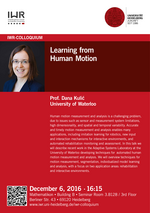
IWR-Colloquium Winter Term 2016 / 2017
"Learning from Human Motion"
Prof. Dana Kulić • University of Waterloo, Canada
December 6, 2016 • 16:15
Human motion measurement and analysis is a challenging problem, due to issues such as sensor and measurement system limitations, high dimensionality, and spatial and temporal variability. Accurate and timely motion measurement and analysis enables many applications, including imitation learning for robotics, new input and interaction mechanisms for interactive environments, and automated rehabilitation monitoring and assessment. In this talk we will describe recent work in the Adaptive Systems Laboratory at the University of Waterloo developing techniques for automated human motion measurement and analysis. We will overview techniques for motion measurement, segmentation, individualized model learning and analysis, with a focus on two application areas: rehabilitation and interactive environments.
Location: Mathematikon Building B • Seminar Room 3.B128 / 3rd Floor • Berliner Str. 43 • 69120 Heidelberg
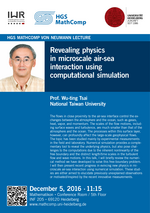
HGS MathComp von Neumann Lecture
"Revealing physics in microscale air-sea interaction using computational simulation"
Prof. Wu-ting Tsai • National Taiwan University
December 5, 2016 • 11:15
The flows in close proximity to the air-sea interface control the exchanges between the atmosphere and the ocean, such as gases, heat, vapor, and momentum. The scales of the flow motions, including surface waves and turbulence, are much smaller than that of the atmosphere and the ocean. The processes within this surface layer, however, can profoundly affect the large-scale geophysical flows. The topic has been studied mainly by experimental measurements in the field and laboratory. Numerical simulation provides a complementary tool to reveal the underlying physics, but also pose challenges to the computations due to the inherent nonlinearity of the free boundary and the distinct length/time scales in the turbulent flow and wave motions. In this talk, I will briefly review the numerical method we have developed to solve this free-boundary problem. I will then present recent progress in evincing new physics in microscale air-sea interaction using numerical simulation. These studies are either aimed to elucidate previously unexplained observations or motivated/inspired by the recent innovative measurements.
Location: Mathematikon • Conference Room / 5th Floor • Im Neuenheimer Feld 205 • 69120 Heidelberg

IWR-Colloquium Winter Term 2016 / 2017
"The role of numerical analysis in multi-physics applications"
Prof. Barbara Wohlmuth • Technical University of Munich
November 9, 2016 • 16:15
In this talk, we address several aspects of model and cost reduction techniques for the numerical simulation of PDEs. Firstly, we consider tearing and interconnection strategies in combination with interface models and reduced basis methods. These techniques are of special interest in the case of vibro-acoustic simulation and can largely reduce the number of degrees of freedom. Numerical results in case of orthotropic material laws are given for a violinbridge as well as a timber building.
Secondly, we discuss surrogate models which aim at a complexity reduction. Here we introduce locally mass conservative scheme in a local postprocessing step as well as adaptive control techniques for resilient multigrid solvers. In all cases, we provide the numerical analysis, algortihmic aspects and illustrative large scale results.
Location: COS (Centre for Organismal Studies) • Lecture Hall (Room 00.005) / Ground Floor • Im Neuenheimer Feld 230 • 69120 Heidelberg
Talk
"Method of multiple shooting for computing shortest descending paths
on convex terrains"
Prof. Phan Thanh An • Institute of Mathematics, Hanoi
November 3, 2016 • 14:15
Given a polyhedral terrain and two points p, q on the terrain, a path joining p to q on the terrain is descending if the z-coordinate of a point v never increases while we move v along the path from p to q. The problem of finding shortest descending paths joining two given points on a polyhedral terrain was posed first by de Berg and van Kreveld (in Algorithmica, 18 (1997), pp. 306-322). Recently, the problem of finding approximations of such paths is considered by Ahmed, Lodha, and Lubiw (2010), Wei and Joneja (2013), Cheng and Jin (2014), etc. using Steiner point, graph, and sequence tree techniques.
In this talk we introduce the method of multiple shooting for solving the problem. It includes the factors: (f1) partition of the terrain, (f2) the straightness condition for the shortest descending paths at shooting points, and (f3) update of shooting points. In particular, the method does not rely on Steiner point, graph and sequence tree techniques on the entire terrain. If the straightness condition is satisfied then we obtain a local shortest descending path.
The corresponding algorithm is implemented in C++ using CGAL. Numerical results nonetheless indicate that the result is close to a local shortest descending path, even if it does not fulfil the straightness condition.
Location: Mathematikon • Seminar Room 11 • Im Neuenheimer Feld 205 • 69120 Heidelberg
Talk
"Variable selection and outlier detection as a MIP"
Prof. Stéphane Canu • INSA Rouen • France
October 31, 2016 • 16:00
Dimension reduction or feature selection is an effective strategy to handle contaminated data and to deal with high dimensionality while providing better prediction. To deal with outlier proneness and spurious variables, we propose a method performing the outright rejection of discordant observations together with the selection of relevant variables. To solve this problem, it is recasted as a mixed integer program which allows the use of efficient commercial solver. Also we propose an alternate projected gradient algorithm (proximal) so get a nice appoximated solution.
Location: Mathematikon • Conference Room / 5th Floor • Im Neuenheimer Feld 205 • 69120 Heidelberg
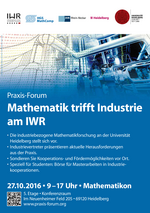
Praxis-Forum
"Mathematik trifft Industrie am IWR"
27. Oktober 2016 • 09:00 - 17:00 Uhr
Wissenschaftliches Rechnen hat sich in zahlreichen Bereichen der Industrie und Wirtschaft zur entscheidenden Schlüsseltechnologie entwickelt. Seit mehr als 25 Jahren betreiben die Forschungsgruppen des Interdisziplinären Zentrums für Wissenschaftliches Rechnen (IWR) hochtechnologisch relevante Forschung.
Gemeinsam mit Partnern aus Wirtschaft und Industrie realisieren sie richtungsweisende Forschungsprojekte. Die Knowledge Transfer Platform gibt wichtige Impulse für den Wissenstransfer zwischen Forschung und Industrie.
- Die industriebezogene Mathematikforschung an der Universität Heidelberg
stellt sich vor. - Industrievertreter präsentieren aktuelle Herausforderungen aus der Praxis.
- Sondieren Sie Kooperations- und Fördermöglichkeiten vor Ort.
- Speziell für Studenten: Börse für Masterarbeiten in Industriekooperationen.
Die Veranstaltung ist öffentlich. Der Eintritt ist frei.
Um Anmeldung unter www.praxis-forum.org wird bis zum 23. Oktober 2016 gebeten.
Veranstaltungsort: Mathematikon • Konferenzraum / 5. Etage • Im Neuenheimer Feld 205 · 69120 Heidelberg
Talk
"Convergence of numerical schemes for the compressible Navier-Stokes system via measure-valued solutions"
Professor Eduard Feireisl • Institute of Mathematics of the Academy of Sciences of the CR, Prague
October 20, 2016 • 15:00
We show how the theory of measure-valued solutions can be used to show convergence for certain numerical schemes approximating the compressible Navier-Stokes system. Analysis is based on estimates based on the relative energy inequality adapted to oscillatory solutions.
After the lecture (4pm) you are cordially invited to 'Meet the lecturer' and have a coffee and pretzel in the Common Room, 5th floor.
Location: Mathematikon • Seminar Room 10 / 5th Floor • Im Neuenheimer Feld 205 • 69120 Heidelberg
Talk
"Mathematical modeling and numerical analysis for incommensurate 2D materials"
Professor Mitchell Luskin • University of Minnesota, USA
October 7, 2016 • 15:15
The unique electronic, optical, and mechanical properties of 2D materials have sparked an extraordinary level of theoretical and experimental activity. Stacking a few layers of 2D materials such as graphene and molybdenum disulfide, for example, opens the possibility to tune the electronic and optical properties of these materials. One of the main issues encountered in the mathematical and computational modeling of layered 2D materials is that lattice mismatch and rotations between the layers destroy the periodic character of the system.
Even basic concepts like the Cauchy-Born strain energy density, the electronic density of states, and the Kubo-Greenwood formulas for transport properties have not been given a rigorous analysis in the incommensurate setting. New approximate approaches will be discussed and the validity and efficiency of these approximations will be examined from mathematical and numerical analysis perspectives.
Location: Mathematikon • Conference Room / 5th Floor • Im Neuenheimer Feld 205 • 69120 Heidelberg
International Symposium on the Neuromechanics of Human Movement
"Invitation to the Frontier Session"
October 4, 2016 • 17:30
"Muscle synergies for motor control"
Professor Andrea d'Avella • University of Messina, Italy
"The mechanics in the neural control of locomotion"
Assistant Professor Hartmut Geyer • Carnegie Mellon University, USA
As part of the Neuromechanics 2016 symposium, two public talks will be held by leading international scientists on topics related to human neuromechanics and motor control. This "Frontiers Session" is scheduled from 17:30 to 19:15 on October 4 in the Alte Aula of Heidelberg University. There will be a reception in the Bel Etage at the end of the talks. Interested researchers from the IWR are welcome to attend the session. No registration is necessary.
The website with more information is available here.
Location: Alte Universität • Alte Aula • Grabengasse 1 • 69117 Heidelberg
Talk
"Understanding Movement Skills using Simulation"
Professor Debesh K. Das • Jadavpur University, Calcutta, India
September 19, 2016 • 11:30
The talk introduces a special class of Boolean functions known as root functions. We show that there exists such class of Boolean functions, which can never appear as faulty response in irredundant two-level AND-OR combinational circuits even when any arbitrary multiple stuck-at faults are injected. Conversely, we show that any other Boolean function can appear as a faulty response in an irredundant realization of some root function under certain stuck-at faults. We characterize this new class of functions and explore their different properties. We show that for n variables, their number is exactly equal to the number of independent dominating sets in a Boolean n-cube. Also, we show that an n-variable root-function with minimum number of true minterms, where n = 2k - 1; k > 2, possesses some inherent error detection/correcting properties.
Dr. Debesh K. Das received the B.E. and M.E. degrees in electronics and telecommunication engineering and the Ph.D. degree in Engineering from Jadavpur University, Calcutta, India. He is currently with the Department of Computer Science and Engineering, Jadavpur University, as a Professor. Prior to this, he served as Minister-in-Charge of Information Technology in the Govt. of West Bengal. His research interests include logic synthesis and testing of VLSI circuits and fault-tolerant computing. He has published more than 100 papers in reputed Journals and International Conference Proceedings.
Location: Mathematikon • Seminar Room 10 / 5th Floor • Im Neuenheimer Feld 205 • 69120 Heidelberg
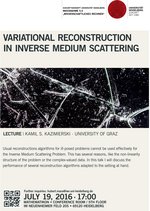
ZUK 5.4 Lecture
"Variational Reconstruction in Inverse Medium Scattering"
Kamil S. Kazimierski • University of Graz
July 19, 2016 • 17:00
Usual reconstructions algorithms for ill-posed problems cannot be used effectively for the Inverse Medium Scattering Problem. This has several reasons, like the non-linearity structure of the problem or the complex-valued data. In this talk I will discuss the performance of several reconstruction algorithms adapted to the setting at hand.
Further inquiries: hubert.mara@iwr.uni-heidelberg.de
Location: Mathematikon • Conference Room / 5th Floor • Im Neuenheimer Feld 205 • 69120 Heidelberg

ZUK 5.4 Vorträge
“Computeranwendungen in der Archäologie”
18. Juli 2016 • 16:15
"Der Dipylon-Meister und seine engsten Werkstattkollegen – Neues zu Altbekanntem"
Stephan Karl • Universität Graz
Die Erzeugnisse der Dipylon-Werkstatt, einer in Athen etwa von der Mitte bis in das 3. Viertel des 8. Jahrhunderts v. Chr. arbeitenden Keramikwerkstatt, gehören zu den eindrucksvollsten Beispielen der attisch-geometrischen Keramik. Seit den grundlegenden stilistischen Arbeiten, insbesondere durch John N. Coldstream, wird neben der Hand des Dipylon-Meisters noch ein sehr enger Kreis von Töpfern bzw. Malern geschieden, die in unmittelbarer Nähe zum Meister arbeiteten (Coldstreams „closer associates“), zuweilen auch zusammen ein gemeinsames Werk dekorierten. Der vorliegende Beitrag zur Dipylon-Werkstatt widmet sich, ausgehend von einem erst 2014 bekannt gewordenen Dipylon-Fragment an der Universität Graz, den Werken dieser „ersten Reihe“ von Werkstattkollegen des Dipylon-Meisters. Er beginnt dort, wo Emil Kunze mit seiner wegweisenden Arbeit zu den Disiecta Membra attischer Grabkratere aufgehört hat – mit der Rekonstruktion dieser Gefäße, deren Fragmente heute über mehrere europäische Sammlungen verstreut sind. Insbesondere der Krater Kunze Nr. IV (Coldstream GGP, Nr. 11), von dem nun mit aller Wahrscheinlichkeit auch die Vorderseite der Hauptzone wieder gewonnen werden konnte, eröffnet einen neuen Blickwinkel auf das Oeuvre des Dipylon-Meisters bzw. seiner Werkstattkollegen. Die vorgestellte Rekonstruktion dieses Kraters aus dem Kreis der Werkstattkollegen ergibt nämlich ein Zwillingsstück zum bekannten Prothesis-Fragment Louvre A 517, das von Coldstream jedoch dem Meister selbst zugewiesen wurde (Coldstream GGP, Nr. 4). Dies führt konsequenterweise zu weiteren Fragestellungen: Wie weit sind wir überhaupt in der Lage, Malerhände im starren Korsett des geometrischen Stils zu erkennen? Ist nun diese sehr charakteristische Hand, wie sie an den vorgestellten Krateren sichtbar wird, dem Dipylon-Meister, weiterhin einem Werkstattkollegen oder doch eher einem Maler zuzuweisen, der dann aber nach seinem bedeutendsten Werk, Maler von Louvre A 517 genannt werden sollte? Schlussendlich: Wer ist der Dipylon-Meister?
"...darf's auch ein bisschen mehr sein? Mehrwert mathematischer Bildverarbeitung in der Archäologie"
Kamil S. Kazimierski • Universität Graz
Der Einzug der Bildverarbeitung in der Archäologie ein spannender, neuer Aspekt der wissenschaftlichen Einordnung und Interpretation archäologischer Artefakte. Insoweit ist die Arbeit an und mit Computer-Daten, eine weitere Facette der „Ära der Digitalisierung“ der wissenschaftlichen Arbeit.
Die Verarbeitung digitaler Daten keramischer Objekte ist erfolgreich, falls zwei Faktoren zusammenkommen. Zum einen müssen die erhobenen Daten geeignet sein, die partikuläre, zum jeweiligen Objekt zugehörige Fragestellung zu beantworten. Zum anderen müssen die zur Verfügung stehenden digitalen Werkzeuge in der Lage sein, den gewünschten wissenschaftlichen Mehrwert aus diesen Daten herauszuarbeiten. In anderen Worten, es reicht nicht, dass die Antwort in den Daten steckt, es müssen auch an die Bedürfnisse der archäologischen Forschung zugeschnittene digitale Frameworks verfügbar sein, welche diese Antwort auch zugänglich machen.
Der Vortrag behandelt einige Beispiele solcher Frameworks.
Rückfragen: hubert.mara@iwr.uni-heidelberg.de
Location: Mathematikon • Konferenzraum / 5. Stock • Im Neuenheimer Feld 205 • 69120 Heidelberg

ZUK 5.4 Workshop
“ilastik: Interactive Machine Learning for the Life Sciences”
July 11-15, 2016
ilastik is a simple, user-friendly tool for interactive image classification, segmentation and analysis. It can automatically segment images in up to 5D, track animals and dividing objects and count without detection, using versatile machine learning algorithms.
- Monday, July 11 – Beginner day
- Tuesday, July 12 – Advanced workshop
- Wednesday, July 13 – Tracking workshop
- Thursday, July 14 – Special session on large-scale usage of ilastik and its extensions
- Friday, July 15 – Roadmap and future development planning
Please register via www.ilastik.org
Location: Mathematikon • Im Neuenheimer Feld 205 • 69120 Heidelberg

IWR-Colloquium Summer Term 2016
"Modelling collective cell motion in biology"
Prof. Philip K. Maini • University of Oxford
July 6, 2016 • 16:15
Collective cell motion is a common phenomenon occurring in normal development, repair and disease. Many different types of theoretical models have been proposed for this phenomenon, ranging from systems of partial differential equations, to hybrid cellular automata and discrete cell based models. I will review some recent work we have done in this area, with application to cancer invasion, cranial neural crest migration and epithelial sheet movement.
This lecture is jointly organized by the IWR and the BIOQUANT.
Location: Mathematikon • Im Neuenheimer Feld 205 • 69120 Heidelberg • 5th Floor / Conference Room
62. Heidelberger Bildverarbeitungsforum
"Hochleistungsbildaufnahmesysteme"
5. Juli 2016 • 11:00 bis 17:00 Uhr
Lange sah es so aus, als sei mit CCD-Bildsensoren der Endpunkt der Entwicklung von Bildsensoren erreicht, weil alle Konkurrenzentwicklungen nicht die Qualität dieses Sensortyps erreichten. Spätestens mit der Ankündigung von Sony, die CCD-Sensortechnik aufzugeben, ist aber klar geworden, dass die CMOS-Sensorik die CCD-Technologie in vielen Qualitätsparametern nicht nur eingeholt, sondern überholt hat. Zusammen mit der Möglichkeit, immer mehr Vorverarbeitung in den Sensor selbst zu integrieren, bahnt sich eine stürmische Weiterentwicklung der Bildaufnahmetechnik an.
Das 62. Heidelberger Bildverarbeitungsforum mit dem Schwerpunktthema Hochleistungsbildaufnahmesysteme zeigt auf, was schon erreicht wurde und wohin die Reise geht. Die Vorträge behandeln hochempfindliche Bildsensoren (Einzelphotonennachweis), Bildsensoren für elektromagnetische Strahlung außerhalb des sichtbaren ereiches und für Teilchenstrahlung, Bildaufnahme mit einem hohen Signalumfang, der sogar den des menschlichen Sehsystems übertrifft, hyperspektrale Bildsensoren und hochqualitative Farbbildsensoren mit Bayer Pattern.
Die Mittags- und Kaffeepause geben ausreichend Zeit für praktische Demonstrationen an zum Inhalt des Forums passenden Exponaten in der Industrieausstellung, zur Diskussion von Posterbeiträgen und für informative Gespräche unter den Teilnehmern und mit den Referenten. Zusätzlich gibt es mehrere Möglichkeiten zu einer Führung durch die Firma ProxiVision.
Anmeldung unter: www.aeonserver.de/bvforum/bv_anmeldung.php
Veranstaltungsort: ProxiVision GmbH / Tobbaccon Hotel, Bensheim
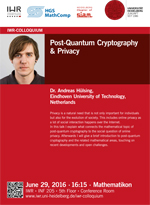
IWR-Colloquium Summer Term 2016
"Post-Quantum Cryptography & Privacy"
Dr. Andreas Hülsing • Eindhoven University of Technology, Netherlands
June 29, 2016 • 16:15
Privacy is a natural need that is not only important for individuals but also for the evolution of society. This includes online privacy as a lot of social interaction happens over the Internet. In this talk I explain what connects the mathematical topic of post-quantum cryptography to the social question of online privacy. Afterwards I will give a brief introduction to post-quantum cryptography and the related mathematical areas, touching on recent developments and open challenges.
This lecture is jointly organized by the IWR and the Heidelberg Chapter of SIAM.
Location: Mathematikon • Im Neuenheimer Feld 205 • 69120 Heidelberg • 5th Floor / Conference Room
Vortrag
"Nach Dr. Google nun Prof. App? Chancen und Risiken von Gesundheitsapps"
Monika Pobiruchin • Hochschule Heilbronn
22. Juni 2016 • 19:15 - 21:00 Uhr
Smartphones und Apps sind mittlerweile ein unerlässlicher Begleiter im Alltag vieler Menschen. Fahrkartenkäufe werden ebenso „mobil“ abgewickelt wie der schnelle Blick aufs Girokonto. Aber was ist mit dem Symptomtagebuch für Allergiker? Der App für die Raucherentwöhnung? Oder der Fitnessapp inklusive individuellem Trainingsplan für den nächsten Marathon? Auch hier gilt: „There’s an app for that.“
Doch der Markt ist unübersichtlich und weitestgehend unreguliert. Gesundheitsbewussten Bürgern, Patienten und auch Ärzten fehlt oft der Durchblick im „App-Dschungel“. Monika Pobiruchin wird in ihrem Vortrag aus der Sicht der Medizininformatik das Spannungsfeld zwischen leichtzugänglicher Funktionalität und Qualitätsstandards im Gesundheitssektor beleuchten und aktuelle Entwicklungen im Kontext von Gesundheitsapps vorstellen.
Monika Pobiruchin ist Medizininformatikerin und arbeitet als Wissenschaftliche Mitarbeiterin am GECKO-Institut der Hochschule Heilbronn. Neben der Analyse von Routinedaten des Gesundheitswesens forscht sie im Kontext der patienten-generierten Daten. Sie ist stellvertretende Leiterin der Projektgruppe „Consumer Health Informatics“ der Deutschen Gesellschaft für Medizinische Informatik, Biometrie und Epidemiologie.
Veranstaltungsort: Mathematikon • Im Neuenheimer Feld 205 • 69120 Heidelberg • Seminarraum C (EG)
Kontakt: Prof. Barbara Paech
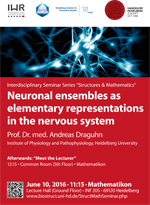
Interdisciplinary Seminar Series "Structures and Mathematics"
"Neuronal ensembles as elementary representations in the nervous system"
Prof. Dr. med. Andreas Draguhn • Institute of Physiology and Pathophysiology, Heidelberg University
June 10, 2016 • 11:15
Studies of the nervous system are performed at multiple system levels, beginning with the structure and function of single molecules (e.g. ion channels), electrochemical processes at the level of single cells (e.g. generation of action potentials, synaptic transmission), activity in multi-neuronal networks (e.g., processing of visual inputs in the retina), large-scale spatiotemporal patterns in the nervous system (e.g., brain-wide activation patterns during cognitive task performance) and, ultimately, at the cognitive-behavioral level of the whole organism (perception, motion, decision making, emotions etc.). In real live, processes at all these levels work together, such that simple bottom-up or top-down models of brain function are far too simple.
This complexity is one of the reasons why mathematical approaches are indispensable in modern neuroscience. We are dealing with highly parallel data, e.g. simultaneous recordings from multiple neurons in electrophysiology, or from millions of volume elements in functional brain imaging. In addition, the emergent properties of complex systems like neuronal networks cannot be simply predicted from linear causal relations and, thus, are often inferred from computer simulations. Third, we are beginning to reveal more and more structural details of the brain – the functional consequences of these boundary conditions are again a topic for mathematicians and network scientists.
In my presentation, I will exemplify some major research problems and approaches of modern neuroscience, focusing on the level of neuronal networks. Our leading question is: How does the brain represent a perception, a memory, a planned action or a motor program? Most neuroscientists agree that this ‘coding’ is performed by multiple cells which are co-activated in a reproducible manner. These sets of neurons are called ensembles or, in other research traditions, assemblies. They can be reproducibly activated even by incomplete input patterns, forming stable spatio-temporal structures or (in one specific approach) attractors in the network’s state-space. In most cases, activation of ensembles happens on top of synchronous network oscillations which provide a temporal scaffold (or ‘clock’) for coordination of the multi-neuronal activity pattern.
In this presentation, we shall discuss the concept of ensembles and its implications for the multiplicity, stability and plasticity of different representations. We will highlight some specific questions based on own and other’s data, mainly from memory-forming networks in the rodent hippocampus. Key questions are: What are the key properties of hippocampal ensembles? How are single neurons bound into reproducible spatiotemporal patterns? How are non-participating neurons reliably suppressed during activation of a given ensemble? How are local ensembles bound into large-scale functional networks?
All of these questions require multidisciplinary approaches including cell and systems physiology, behavioral neurosciences and, importantly, advanced data analysis and mathematical modelling. The importance of (and sometimes lack of) generally accepted quantitative models of neuronal networks, their cellular constituents and their large-scale effects will become clear from each of the multiple open questions mentioned during the presentation.
Location: Mathematikon • Im Neuenheimer Feld 205 • 69120 Heidelberg • Lecture Hall (Ground Floor)

MOBOCON
"Workshop on Model-based Optimizing Control"
June 9-10, 2016
"Model-based Optimizing Control - from a vision to industrial reality" (MOBOCON) is a European research project co-financed by the European Commission in the 7th Framework Programme (ERC Advanced Grant).
The goal of this project is to overcome obstacles for the industrial application of optimization-based control by developing methods for the enhanced robustness and failure tolerance and for the reduction of the modeling effort as well as by developing new concepts for the interaction with the plant operators.
The aim of the workshop is to showcase the research results of the MOBOCON project to a wide international audience mainly from industry.
Registration: The workshop is sponsored by the MOBOCON project in cooperation with the sponsors of the Modeling Day. Registration (via the Modeling Day website) is free of charge.
Location: Mathematikon • Im Neuenheimer Feld 205 • 69120 Heidelberg • Conference Room (5th Floor)

11. Modellierungstag Rhein-Neckar
"Mathematische Optimierung in der Industrie"
9. Juni 2016 • 14:00 Uhr
In industriellen Produktions- und Fertigungsprozessen spielt die Optimierung eine zentrale Rolle. Die Herstellung von Produkten soll aus ökonomischen und ökologischen Gründen effizient, ressourcenschonend und kostengünstig erfolgen. Während sich dieses Paradigma seit Beginn der Industrialisierung nicht verändert hat, hat die Komplexität der zu optimierenden Prozesse rasant zugenommen.
Moderne Produktionsketten haben eine Vielzahl an Einflussfaktoren und Parametern. Die Planung parallel laufender Fertigungsprozesse und die Einhaltung regulatorischer Rahmenbedingungen stellen zusätzliche Anforderungen an die Prozessoptimierung.
Die mathematische und computergestützte Optimierung stellt sich dieser komplexen Aufgabe. Ausgehend von Modellen einzelner Produktionsketten verbessert der Einsatz computerbasierter Optimierung auf unterschiedlichen Ebenen Ablaufprozesse. Dabei werden neue mathematische Verfahren eingesetzt, um zu fehlerkontrollierten Systemabläufen zu kommen. Drei Aufgaben stehen im Mittelpunkt:
- Durch Parameterschätzung in Verbindung mit Verfahren der optimale Steuerung werden chemische, mechanische und biochemische Verfahren verbessert.
- Echtzeitfähige gemischt-ganzahlige Optimierung und Limited-Horizon-Verfahren erhöhen die Sicherheit von Produktionsverfahren – speziell auch im Nicht-Regelbetrieb.
- Scheduling und die Modellierung von Unsicherheiten (Uncertainty Quantification) kommen in der längerfristigen Planung von Prozessabläufen zum Einsatz.
Der Modellierungstag will den Gedankenaustausch zwischen Forschern, Entwicklern, Theoretikern und Anwendern der mathematischen Optimierung in der Industrie fördern. Als Diskussionsgrundlage dienen dabei u.a.:
- Praktische Fragestellungen aus der Industrie
- Erfahrungsberichte über Anwendungen mit Software und Algorithmen aus dem Gebiet mathematische Optimierung
- Vorstellung von Softwarewerkzeugen, die den Einsatz mathematischer Programmierung in der Praxis effektiver gestalten
Der 11. Modellierungstag findet im Rahmen des Industrieworkshops „Model-based Optimizing Control – From a Vision to Industrial Reality“ (9.–10. Juni 2016) statt, der von Wissenschaftlern des europäischen Forschungsprojekts MOBOCON organisiert wird (Vortragssprache Englisch).
Die Teilnahme ist kostenfrei. Um Anmeldung unter www.modellierungstag.de wird bis zum 5. Juni 2016 gebeten.
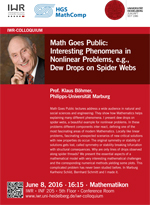
IWR-Colloquium Summer Term 2016
"Math Goes Public: Interesting Phenomena in Nonlinear Problems"
Prof. Klaus Böhmer • Philipps-Universität Marburg
June 8, 2016 • 16:15
Math Goes Public lectures address a wide audience in natural and social sciences and engineering: They show how Mathematics helps explaining many different phenomena. I present dew drops on spider webs, a beautiful example for nonlinear problems. In these problems different components inter react, defining one of the most fascinating areas of modern Mathematics. Locally like linear problems, fascinating unexpected scenarios of new critical solutions with new properties do occur: The original symmetry or stability of solutions gets lost, called symmetry or stability breaking bifurcation with structural consequences. Why are only lines of drops observed along spider threads? We present the essential aspects of a mathematical model with very interesting mathematical challenges and the corresponding numerical methods yielding some plots. This complicated problem has never been studied before. In Marburg Karlheinz Schild, Bernhard Schmitt and I made it.
Location: Mathematikon • Im Neuenheimer Feld 205 • 69120 Heidelberg • 5th Floor / Conference Room
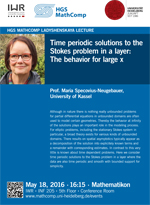
HGS MathComp Ladyshenskaya Lecture
"Time periodic solutions to the Stokes problem in a layer - The behavior for large x"
Prof. Maria Specovius-Neugebauer • University of Kassel
May 18, 2016 • 16:15
Although in nature there is nothing really unbounded problems for partial differential equations in unbounded domains are often used to model certain geometries. Thereby the behavior at infinity of the solutions plays an important role in the modeling process. For elliptic problems, including the stationary Stokes system in particular, a broad theory exists for various kinds of unbounded domains. There results on spatial asymptotics typically appear as a decomposition of the solution into explicitely known terms and a remainder with corresponding estimates. In contrast to this very little is known about time dependent problems. Here we consider time periodic solutions to the Stokes problem in a layer where the data are also time periodic and smooth with bounded support for simplicity.
Location: Mathematikon • Im Neuenheimer Feld 205 • 69120 Heidelberg • 5th Floor / Conference Room

IWR-Colloquium Summer Term 2016
"Computational Progress in Linear and Mixed Integer Programming"
Prof. Robert E. Bixby • Rice University, TX / USA
May 4, 2016 • 16:15
We will look at progress in Linear Programming (LP) and Mixed Integer Programming (MIP) software over the last 25 years. As a result of this progress, modern LP codes are capable of robustly and efficiently solving instances with multiple millions of variables and constraints.
With these LP advances as a foundation, MIP provides the modeling framework and the key solution technology behind prescriptive analytics. The performance improvements in MIP codes have been nothing short of remarkable, well beyond those of LP, and have transformed this technology into an out-of-the box tool with an almost unlimited range of real-world applications.
Location: Mathematikon • Im Neuenheimer Feld 205 • 69120 Heidelberg • 5th Floor / Conference Room
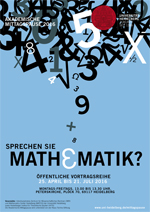
Akademische Mittagspause 2016
"Sprechen Sie Mathematik?"
25. April bis zum 21. Juli 2016 • 13:00 bis 13:00 Uhr
Mit der "Akademischen Mittagspause", die im Sommersemester 2016 unter der Überschrift "Sprechen Sie Mathematik?" steht, will die Universität Heidelberg wissenschaftliche Inhalte für ein fachfremdes Publikum verständlich machen. In 61 Kurzvorträgen stellen Wissenschaftler ihre Forschungsarbeiten aus unterschiedlichen mathematischen Gebieten vor. Das Spektrum der Themen reicht von gebrochenen Symmetrien über die Rolle des Zufalls bei der Ordnung des Erbmaterials bis zur Bekämpfung von Parasiten mithilfe der Mathematik. In diesem Semester wird die "Akademische Mittagspause" gemeinsam vom Interdisziplinären Zentrum für Wissenschaftliches Rechnen (IWR) und dem Mathematics Center Heidelberg der Universität Heidelberg (MATCH) sowie dem Heidelberger Institut für Theoretische Studien (HITS) ausgerichtet.
Die Akademische Mittagspause 2016 wird unterstützt durch die Klaus Tschira Stiftung.
Vom 25. April bis zum 21. Juli 2016, täglich montags bis freitags (außer feiertags), 13:00 bis 13:30 Uhr
Peterskirche, Plöck 70, 69117 Heidelberg
Das vollständige Programm der Akademischen Mittagspause 2016 finden Sie hier.
Talk
"Understanding Movement Skills using Simulation"
Prof. Michiel van de Panne • Department of Computer Science, University of British Columbia, Canada
April 25, 2016 • 13:30
Interactive physics-based simulations are now capable of reproducing a growing number of motion skills, often with a focus on generating agile-and-robust locomotion. In this talk, I review recent progress in simulation-based models of human and animal motion as used for computer animation, where they seek to replace simpler kinematic models based on motion-capture.
We will discuss the roles of optimization, machine learning, and simplified models in these approaches, as well as what insights might be shared between robotics and our simulation-based work in animation. A wide variety of animated results will be shown to illustrate the capabilities of current methods. I'll also identify several research directions where we still need to see significant progress.
Michiel van de Panne is a Professor in the Department of Computer Science at the University of British Columbia (UBC), with research interests that span computer graphics, computer animation, and robotics, with a strong focus on modeling human and animal motion and the motor skills that underly their movement. He recently completed 10 years as a Tier 2 Canada Research Chair in Computer Graphics and Animation at UBC. In 2002, he co-founded the ACM/Eurographics Symposium on Computer Animation (SCA), the leading forum dedicated to computer animation research, and has served for many years on its steering committee. He has served as Associate Editor of ACM Transactions on Graphics and regularly serves on program committees that include ACM SIGGRAPH and SCA. He has served as conference co-chair for CAS 1997, SCA 2002, Graphics Interface 2005, SBIM 2007, and SCA 2011. His research has been recognized with an NSERC Discovery Accelerator Supplement and grants from NSERC, GRAND, Adobe, and MITACS. His research has been used in games, visual effects for film, games, and robotics.
Location: Mathematikon • Seminar Room / 5th Floor (Room 5/104) • Im Neuenheimer Feld 205 • 69120 Heidelberg

HGS MathComp
Praxis-Forum "Open Data"
15. April 2016 • 09:00 Uhr
Zu einem Praxis-Forum „Open Data“ kommen Vertreter verschiedener Forschungseinrichtungen der Universität Heidelberg sowie Partner aus Wirtschaft und öffentlicher Verwaltung am 15. April 2016 an der Ruperto Carola zusammen. In Vorträgen und Diskussionsrunden werden sich die rund 70 Teilnehmer über Innovationen im Umgang mit offenen Daten austauschen sowie Gemeinsamkeiten und Unterschiede der verwendeten fachlichen Ansätze analysieren. Teil des Veranstaltungsprogramms ist auch eine sogenannte Open Tables Session, die praktische Einblicke in die Verwendung von Open Data ermöglicht. Veranstalter des Praxis-Forums sind die Heidelberger Graduiertenschule der mathematischen und computergestützten Methoden für die Wissenschaften (HGS MathComp) der Universität Heidelberg, die InnovationLab GmbH und die BASF SE Ludwigshafen mit Unterstützung der Industrie- und Handelskammer Rhein-Neckar sowie des Komitees für Mathematische Modellierung, Simulation und Optimierung (KoMSO).
Die Verfügbarkeit und der Umgang mit offenen Daten werden zunehmend bedeutsam in unterschiedlichsten Bereichen, beispielsweise in Politikanalyse, Energieforschung und Geoinformationsnetzwerken. Die Art und Weise, wie sich Datenpools heute vernetzen lassen, erschien bis vor wenigen Jahren noch undenkbar. Intelligente Systemlösungen und der Wunsch nach einem umfassenden Zugriff auf Daten zum Zweck der Analyse und zur Nutzung der daraus gewonnenen Erkenntnisse treten dabei zunehmend in Konflikt mit Persönlichkeitsrechten und ethischen Grundsätzen. Die Teilnehmer des Praxis-Forums „Open Data“ werden in diesem Zusammenhang diskutieren, wem die Daten gehören, wer Zugriff darauf hat und wie transparent diese sind. Dabei geht es insbesondere auch um die Frage, wie sich diese Aspekte mit dem Gemeinwohl und den Interessen des Einzelnen in Einklang bringen lassen.
Das Praxis-Forum knüpft an den zehnten Modellierungstag Rhein-Neckar an, der im Dezember vergangenen Jahres mit großer Resonanz zum Thema Open Data und Wissenschaftliches Rechnen in Heidelberg stattgefunden hat. Das Forum und der Modellierungstag bieten Vertretern aus Wissenschaft, Industrie und öffentlicher Verwaltung die Möglichkeit, unterschiedliche Themen anwendungsnah zu diskutieren und dabei den Erfahrungsaustausch zu pflegen.
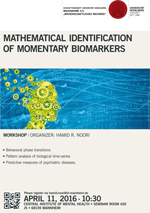
ZUK 5.4 Workshop
“Mathematical Identification of Momentary Biomarkers”
April 11, 2016
• Behavioral phase transitions
• Pattern analysis of biological time-series
• Predictive measures of psychiatric diseases
Please register via hamid.noori@zi-mannheim.de
Location: Central Institute of Mental Health • Seminar Room 420 • J5 • 68159 Mannheim
61. Heidelberger Bildverarbeitungsforum
20 Jahre Heidelberger Bildverarbeitungsforum „Erfolge, Defizite und Zukunftsthemen der Bildverarbeitung“
8. April 2016
Nach zwanzig erfolgreichen Jahren Weiterbildung und Informationsaustausch zwischen Hochschulen und Industrie im Heidelberger Bildverarbeitungsforum mit bisher 60 Veranstaltungen ist es angemessen, Rückblick und Vorschau zu halten. Welche entscheidenden Fortschritte konnten in den letzten zwanzig Jahren erzielt und welche neuen Anwendungsfelder neu erschlossen werden? Welche ungelösten Probleme behindern heute den Fortschritt am meisten? Das 61. Heidelberger Bildverarbeitungsforum bietet die seltene Gelegenheit, Antworten auf mittel- und langfristige Fragen zu erhalten, die im hektischen Alltagsgeschäft untergehen, aber entscheidend für mittel- und langfristige Erfolge in Forschung und Industrie sind.
Aufgrund der begrenzten Teilnehmerzahl ist eine Anmeldung notwendig.
Weitere Informationen finden Sie unter www.bv-forum.de.
Talk
"CV-HAZOP: Introducing Test Data Validation for Computer Vision"
Oliver Zendel & Markus Murschitz • Austrian Institute of Technology, Vienna
April 6, 2016 • 16:00
The validation of computer vision (CV) algorithms is a crucial step to ensure robustness of real world solutions. Two main questions have to be answered: What constitutes good test data and when have we tested enough? It is our mission to find practical solutions to these challenges and in the long run allow CV algorithm certification. In this talk we will present our current results towards systematic testing for CV: the CV-HAZOP (Hazard and Operability Analysis). This is a comprehensive checklist that can be used to evaluate the quality and thoroughness of existing test data sets. It allows comparison between different test sets and can be used to guide the creation of a new data set. In addition to this specific tool we will also give insights on how this process fits into our overall strategy for CV validation.
Location: Mathematikon (Building B) • Berliner Str. 43 • Seminar Room / 3rd Floor
Talk
"Robust Visual Perception for Intelligent Systems"
Dr. Andreas Geiger • Max Planck Institute for Intelligent Systems, Tübingen
March 29, 2016 • 16:00
Perception is a key component of every intelligent system as it enables actions within a changing environment. While humans perceive their environment with seemingly little efforts, computers first need to be trained for these tasks. One of the biggest challenges in computer vision are ambiguities which arise due to the complex nature of our environment and the information loss caused by observing two-dimensional projections of our three-dimensional world. In this talk, I will present several recent results in stereo estimation, 3D reconstruction and motion estimation which integrate high-level non-local prior knowledge for resolving ambiguities that can't be resolved using local assumptions alone. Furthermore, I will discuss the "curse of dataset annotation" and present a method for augmenting video sequences efficiently with semantic information.
Location: Mathematikon (Building B) • Berliner Str. 43 • Seminar Room / 3rd Floor
Talk
"Graphics and Vision Algorithms for Big Visual Data"
Dr. Henning Zimmer, Disney Research Zürich
March 23, 2016 • 16:00
Modern sensors capture the world at ever higher spatial, temporal and angular resolution. For instance, modern cinema cameras record 120 fps at 4k resolution and beyond. Apart from the obvious problems of data management and complexity, more fundamental challenges arise for computer vision and graphics research. In this talk, I will argue that, for very densely sampled input such as light fields, existing approaches often do not scale well and even worse, do not necessarily get the best out of the data. Thus extremely dense sampling poses interesting novel research challenges and opportunities beyond simply improving speed and scalability of existing techniques. I will exemplify this by presenting some of our recent works done at Disney Research concerning 3D scene reconstruction from light fields, panoramic video stitching, and frame interpolation for high resolution videos. In these works we abandoned a number of established practices in the respective fields to efficiently handle extremely densely sampled data and to improve quality compared to the state-of-the-art.
Location: Mathematikon (Building B) • Berliner Str. 43 • Seminar Room / 3rd Floor
Workshop
"DUNE/PDELab Course"
March 7-11, 2016
The Distributed and Unified Numerics Environment (DUNE) is a software framework for the numerical solution of partial differential equations with grid-based methods. Using generic programming techniques it strives for both: high flexibility (efficiency of the programmer) and high performance (efficiency of the program). DUNE provides, among other things, a large variety of local mesh refinement techniques, a scalable parallel programming model, an ample collection of finite element methods and efficient linear solvers.
DUNE-PDELab is a powerful tool for implementing discretisations of partial-differential equations. It helps to substantially reduce the time to implement discretizations and solvers for (systems of) PDEs based on DUNE. It is not only suitable for rapid prototyping but also for building highly performant simulation software and is used by a variety of projects already.
This one week course will provide an introduction to the most important DUNE modules and especially to DUNE-PDELab. At the end the attendees will have a solid knowledge of the simulation workflow from mesh generation and implementation of finite element and finite volume methods to visualization of the results. Topics covered are the solution of stationary and time-dependent problems, as well as local adaptivity, the use of parallel computers and the solution of non-linear PDE's and systems of PDE's.
60. Heidelberger Bildverarbeitungsforum
„Multisensorielle 3D-Datenfusion“
1. März 2016
In den letzten Jahren hat die optische Erfassung von Objekten und Szenen sich rasant weiterentwickelt. Es gibt eine schier unüberschaubare Fülle unterschiedlicher Verfahren, die dennoch alle ihre spezifischen Grenzen und Unzulänglichkeiten haben. Daher kommt der Fusion unterschiedlicher Verfahren ein besonderer Stellenwert zu.
Das 60. Heidelberger Bildverarbeitungsforum mit dem Schwerpunktthema Multisensorielle 3D-Datenfusion gibt einen didaktisch aufbereiteten Überblick über diese Fusionsverfahren, die dabei eingesetzten Methoden, und illustriert diese an einer breiten Palette von Anwendungen. Die Vorträge umfassen Verfahren mit durchdringender Strahlung (Röntgenaufnahmen), klassische Triangulationsverfahren, darunter passive Stereoaufnahmen und Verfahren mit aktiver Beleuchtung, Laufzeitkameras, photometrisches Stereo und Lichtfeld-basierte Methoden.
Die Mittags- und Kaffeepause geben ausreichend Zeit für praktische Gerätedemonstrationen, für die Exponate der Industrieausstellung, für Poster und informative Gespräche unter den Teilnehmern und mit den Referenten. Neben den ausgedruckten Vorträgen erhalten alle Teilnehmer eine DVD mit einer elektronischen Version der Vorträge und weiteren Informationen.
Weitere Informationen finden Sie unter www.bv-forum.de.
Vortragsveranstaltung
"Die Schrift der Maya und deren digitale Bearbeitung in 2D und 3D"
3. Februar 2016
13:15 – 13:45 Vortrag: "Herausforderungen der Mayaschrift"
Dr. Christian Prager, Akademie der Wissenschaften NRW und Universität, Bonn
Im Rahmen des Forschungsprojekts "Textdatenbank und Wörterbuch des Klassischen Maya" wird derzeit eine maschinenlesbare Annotation der Hieroglyphentexte auf der Grundlage von XML TEI konzipiert und entworfen. Ziel des strukturierten Markups der Mayaschrift ist es die Struktur der Originalschreibung und die Anordnung der Zeichen im Text möglichst genau mit Hilfe von TEI XML abzbilden. Bei partiell entzifferten Mayaschrift kommt das Problem hinzu, dass anstelle von Transliterationen und Transkriptionen unentzifferte Zeichen oder Textstellen mit Hilfe von Codes und Nomenklaturen wiedergegeben werden müssen um auf dieser Grundlage fragliche Zeichen in ihrem jeweiligen Verwendungskontext zu dokumentieren. Die Dokumentation der Originalschreibung ist grundlegend für die epigraphische Arbeit mit syllabischen und logo-syllabischen Hieroglyphen- und Keilschriftsystemen. Unser Projekt hat hier ein Desiderat für die vergleichende Schriftforschung erkannt und möchte in Zusammenarbeit mit Experten für kompexe Schriftsysteme Lösungen auf der Grundlage von XML TEI und Epidoc erabeiten. Im Rahmen des Vortrags in Heidelberg stellen wir die Probleme und Herausforderungen bei der Annotation der Mayaschrift vor.
13:45 – 14:00 Diskussion
14:00 – 14:30 Vortrag "Digitale Epigraphik - Die Erforschung der Hieroglyphentexte und Bildbotschaften der Maya in der virtuellen Forschungsumgebung TextGrid"
Prof. Nikolai Grube, Akademie der Wissenschaften NRW und Universität, Bonn
Die nur teilweise entzifferte Hieroglyphenschrift und Sprache der Mayakultur steht im Mittelpunkt eines Forschungsprojektes der NRW Akademie der Wissenschaften, das in Kooperation zwischen den Universitäten Bonn und Göttingen durchgeführt wird. Ziel ist die Erstellung einer Textdatenbank und ein darauf basierendes Wörterbuchs des Klassischen Maya. Im Rahmen des Projekts werden die Text- und Bildträger systematisch und nach einheitlichen Standards beschrieben, das Ausgangsmaterial auf der Basis von XML maschinenlesbar gemacht und auf diese Weise die Grundlagen für die Kompilation des Wörterbuchs geschaffen. Dieses Unterfangen wird mit Methoden und Technologien aus den digitalen Geisteswissenschaften in Angriff genommen. Wesentliche Voraussetzung ist dabei, dass nicht nur der sprachliche Inhalt der Inschriften und die ikonischen Informationen der Bilddarstellungen, sondern auch Daten über den Inschriften- und Bilddträger (Beschreibungs- oder Metadaten) berücksichtigt und in einer Datenbank angelegt werden. Zu diesem Zweck werden in TextGrid Tools und Workflows entwickelt, welche die I. Dokumentation der Schrift- und Bildträger mit Aufarbeitung des Forschungsstandes, II. die epigraphisch-linguistische Auswertung der Hieroglyphentexte sowie III. Edition der Texte mit Transliteration, Transkription und Übersetzung in einem einzigen System ermöglichen. Die VRE enthält nicht nur Beschreibungen der Textträger oder Informationen die Texte, sondern der Datenbanknutzer bekommt mit Hilfe der Literaturdatenbank auch einen Überblick darüber, welche Autoren sich mit einem Monument befasst oder es publiziert haben, eine Textpassage diskutiert oder erstmals eine bis heute gültige sprachliche Lesung einer Hieroglyphe präsentiert haben. Der Textträger erhält dadurch eine ‚Biographie‘, die eng mit dem Textinhalten verwoben ist und bei der Bedeutungsanalyse von Wörtern berücksichtigt wird.
14:30 – 14:45 Diskussion
Die Vorträge finden am Mittwoch, den 3. Februar um 13 c.t. im Raum 532 am Interdisziplinären Zentrum für Wissenschaftliches Rechnen (IWR), Im Neuenheimer Feld 368 statt.
Auf Grund der begrenzten Platzkapazität wird um Anmeldung per Doodle gebeten.
Weitere Informationen zum Mayawörterbuch finden Sie unter www.mayawoerterbuch.de.
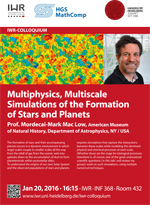
IWR-Colloquium
"Multiphysics, Multiscale Simulations of the Formation of Stars and Planets"
Prof. Mordecai-Mark Mac Low, American Museum of Natural History, Department of Astrophysics, NY / USA
January 20, 2016
The formation of stars and their accompanying planets occurs in a dynamic environment in which larger scales couple to smaller scales all the way from the infall of gas from the cosmic web into galaxies down to the accumulation of dust to form planetesimals within protostellar disks. To understand the origins of our own Solar System and the observed populations of stars and planets requires simulations that capture the interactions between these scales while modeling the dominant physical and chemical processes at each scale. (Whether these set the stage for biological processes elsewhere is, of course, one of the great unanswered scientific questions.) In this talk I will review my group’s work on such simulations, using multiple numerical techniques.

HGS MathComp Talk
"An Introduction to Scalar Field Topology "
Dr. Julien Tierny, French National Centre for Scientific Research
January 18, 2016
Scalar fields are a versatile and integral part of many applications: In computer graphics, they appear in the form of the classical heat kernel shape descriptors. In molecular chemistry simulations, scalar fields derived from electron density are used to model complex molecular interactions.
Scalar fields are very appealing for analysing and visualizing complex data sets because they permit a precise mathematical theory that is largely based on Morse theory.
In this talk, Julien Tierny of the French National Centre for Scientific Research will give an introduction to this topic and outline past and current research. The talk is specifically geared towards an audience of non-experts in topological methods.
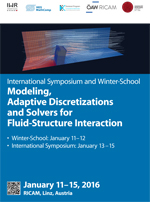
International Symposium and Winter-School
"Modeling, Adaptive Discretizations and Solvers for Fluid-Structure Interaction"
January 11-16, 2016, Linz
Discussion of topical challenges to modeling, discretization and adaptive methods and their efficient numerical solution in the context of fluid-structure interaction
After several decades of intensive research, numerical analysis and simulation of fluid-structure interactions remain a challenging topic with a large number of unresolved problems and issues. While the numerical analysis of the coupled system of equations in terms of well-posedness and convergence is typically limited to simple model problems, a lot of insight have been gained over the years by means of numerical simulations. Established methods like the Arbitrary Lagrangian-Eulerian (ALE) method or the Immersed Boundary Method have been succesfully applied to a wide range of applications, including for example aero-elasticity and aero-acoustics, biomechanics, energy or mechanical engineering.
Nevertheless, there are yet a number of problems, where most of the established methods fail or come to a limit. Problems are caused for example by large structural deformations or contact problems, stiff couplings, extreme parameters or a huge computational complexity. In the last years, a number of novel methods and approaches have been developed to tackle such problems many of them being still subject of ongoing research.
An area of research on its own is the development of efficient solvers for the underlying linear systems of equations. The high complexity of real world applications calls for algorithms that include adaptivity in time and space, model reduction, as well as parallelization. In the case of strong couplings, the coupled system of equations is extremely bad conditioned, such that the design of efficient solvers, e.g. multigrid solvers, is a challenge.
This workshop addresses the previously mentioned challenges and aims at bringing together experts and junior scientists in the fields of modeling, adaptive discretizations and solvers for fluid-structure interaction. To provide a platform in order to teach and learn state-of-the art formulations for fluid-structure interaction, this workshop consists of a two-day-school and a subsequent three-day-symposium. The latter one will consist of invited and contributed presentations of junior scientists and experts whereas the school lectures will be given by three young scientists and experts in their field covering each of the three topics of our symposium.